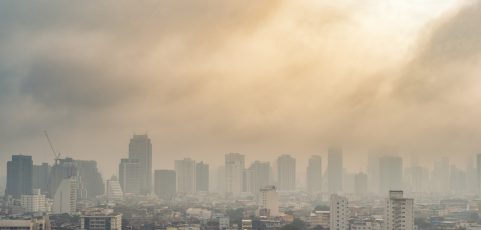What’s in the air you breathe? Is it free of toxins? Air pollution is one of the largest problems of our generation, and the release of Volatile Organic Compounds (VOCs) is a large contributor. Understanding the dangers of these toxic gases will help you protect the air quality in your environment.
How’s your air quality? Protect the health of you and your workers from dangerous pollutants found in VOCs. Learn more here.
When you work with chemicals containing volatile organics in your manufacturing processes, your indoor air quality is threatened. Harmful levels of VOCs are hard to detect by the human nose. Thus, reliable detection systems are necessary to keep you and your workers safe. With lasting health effects like cancer and memory impairment, monitoring volatile organics can’t be overlooked.
What are VOCs exactly?
Volatile organic compounds (or VOCs) are carbon-based chemicals that turn into gaseous form at room temperature. These toxic gases are invisible to the human eye and can be found in many consumer products and industrial processes. Some of the most common VOC substances include formaldehyde, acetaldehyde, phenol, and methylene chloride.
Volatile organics can be found in paint varnishes, cleaning supplies, pesticides, building materials, correction fluids, glues, adhesives, and other chemicals. Be sure to monitor all sources of VOCs to protect your current and future health.
Pro Tip: Installing a photoionization detector to accurately measure the volatile organic molecules in the air near you.
Harmful Levels of VOCs
When dealing with VOCs, there are safe and unsafe levels of concentration to consider. According to the Environmental Protection Agency (EPA), organic pollutants can be 2-5 times higher in interior spaces compared to outdoor air. Installing proper detection systems is crucial for guarding against toxic levels in your working environment.
When measuring volatile organics, you may be presented with the term, Total VOC (or TVOC for short). TVOC is the total concentration of all VOCs found simultaneously in the air. Any volatile organic could be found in a number of elements. Instead of focusing on a single compound, detectors measure the sum concentration of VOCs.
Federal officials haven’t fully regulated VOCs, but the following chart shows the appropriate levels of TVOCs in the air.

Health Effects of Volatile Organics
If you regularly interact with VOCs, your future health could be in danger. Although many signs of VOC poisoning are noticed immediately, some people may experience symptoms days after exposure. Health effects could include eye, nose, and throat irritation, central nervous system damage, the development of cancer, and memory impairment.
According to the EPA, health symptoms associated with exposure to VOCs include:
- Conjunctival irritation
- Nose and throat discomfort
- Headache
- Allergic skin reaction
- Dyspnea
- Decline in serum cholinesterase levels
- Nausea
- Emesis
- Epistaxis
- Fatigue
- Dizziness
If you work with volatile organics, it’s important to have easy access to fresh air in the case of exposure. Those experiencing severe symptoms should contact emergency personnel for immediate assistance.
Protect Yourself from Air Pollutants
Do you regularly deal with volatile organics? Protect your facility’s air quality and guard your employee’s health by installing photoionization detectors, or PIDs. GDS Corp offers a number of PIDs with high energy ultraviolet lights to accurately measure the compounds in your environment.
Could you be exposed to VOCs? Connect with our gas detection experts to find the best detector for your environment.

